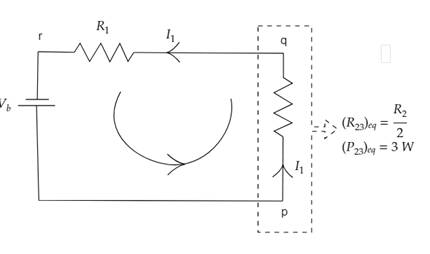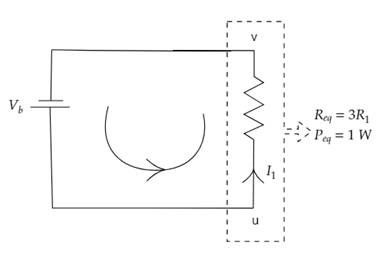
The value of R1, R2, and R3 in circuit.
Answer to Problem 69QAP
R1, R2, and R3 are 27-ohm, 108 ohm and 108 ohm.
Explanation of Solution
Given:
Voltage present in circuit, Vb= 9 V
Power dissipated in each resistor, P1= P2 = P3 = 1.50 W
Formula used: Power dissipates across resistor
Where, P is power dissipated
V = Voltage across resistor
I = Current flowing through resistor
R = Resistance..
Equivalent resistance, when resistance connects in series
Equivalent resistance, when resistance connects in parallel
Equivalent power, when resistance connects in series
Equivalent power, when resistance connects in parallel
Figure:
 .
.
 .
.
 .
.
Calculation:
In figure (1)
Power in each resistance is equal..
Equivalent Power of R2and R3
Equivalent resistance of R2and R3
In figure (2)
Current flowing through resistance
On comparing equation (d) and (e)
So, equivalent resistance of circuit
Equivalent power of circuit
In figure (3)
From equation (f),
From equation (a),
Conclusion:
Thus, the value of
Want to see more full solutions like this?
Chapter 18 Solutions
COLLEGE PHYSICS LL W/ 6 MONTH ACCESS
- Assume a length of axon membrane of about 0.10 m is excited by an action potential (length excited = nerve speed pulse duration = 50.0 m/s 2.0 103 s = 0.10 m). In the resting state, the outer surface of the axon wall is charged positively with K+ ions and the inner wall has an equal and opposite charge of negative organic ions, as shown in Figure P18.43. Model the axon as a parallel-plate capacitor and take C = 0A/d and Q = C V to investigate the charge as follows. Use typical values for a cylindrical axon of cell wall thickness d = 1.0 108 m, axon radius r = 1.0 101 m, and cell-wall dielectric constant = 3.0. (a) Calculate the positive charge on the outside of a 0.10-m piece of axon when it is not conducting an electric pulse. How many K+ ions are on the outside of the axon assuming an initial potential difference of 7.0 102 V? Is this a large charge per unit area? Hint: Calculate the charge per unit area in terms of electronic charge e per squared (2). An atom has a cross section of about 1 2 (1 = 1010 m). (b) How much positive charge must flow through the cell membrane to reach the excited state of + 3.0 102 V from the resting state of 7.0 102 V? How many sodium ions (Na+) is this? (c) If it takes 2.0 ms for the Na+ ions to enter the axon, what is the average current in the axon wall in this process? (d) How much energy does it take to raise the potential of the inner axon wall to + 3.0 102 V, starting from the resting potential of 7.0 102 V? Figure P18.43 Problem 43 and 44.arrow_forwardThe circuit in Figure P18.55 has been connected for several seconds. Find the current (a) in the 4.00-V battery,(b) in the 3.00- resistor,(c)in the 8.00-V battery, and (d)in the 3.00-V battery.(e)Find the charge on the capacitor.arrow_forwardCheck Your Understanding If you place a wire directly across the two terminal of a battery, effectively shorting out the terminals, the battery will begin to get hot. Wiry do you suppose this happens?arrow_forward
- The immediate cause of many deaths is ventricular fibrillation, an uncoordinated quivering of the heart, as opposed to proper beating. An electric shock to the chest can cause momentary paralysis of the heart muscle, after which the heart will sometimes start organized beating again. A defibrillator is a device that applies a strong electric shock to the chest over a time of a few milliseconds. The device contains a capacitor of a few microfarads, charged to several thousand volts. Electrodes called paddles, about 8 cm across and coated with conducting paste, are held against the chest on both sides of the heart. Their handles are insulated to prevent injury to the operator, who calls Clear! and pushes a button on one paddle to discharge the capacitor through the patient's chest Assume an energy of 3.00 102 W s is to be delivered from a 30.0-F capacitor. To what potential difference must it be charged?arrow_forwardConsider the combination of resistors shown in Figure P18.8. (a) Find the equivalent resistance between point a and b. (b) If a voltage of 35.0 V is applied between points a and b, find the current in each resistor. Figure P18.8arrow_forwardFigure 21.55 shows how a bleeder resistor is used to discharge a capacitor after an electronic device is shut off allowing a person to work on the electronics with less risk of shock, (a) What is the time constant? (b) How long will it take to reduce the voltage on the capacitor to 0.250% (5% of 5%) of its full value once discharge begins? (c) If the capacitor is charged to a voltage V0through a 100-O resistance, calculate the time it takes to rise to 0.865V0(This is about two time constants.)arrow_forward
- Consider the circuit shown in Figure P26.24, where C1, = 6.00 F, C2 = 3.00 F. and V = 20.0 V. Capacitor C1 is first charged by closing switch S1. Switch S1 is then opened, and the charged capacitor is connected to the uncharged capacitor by closing Calculate (a) the initial charge acquired by C, and (b) the final charge on each capacitor.arrow_forwardLightbulb A is marked 25.0 W 120. V, and lightbulb B is marked 100. W 120. V. These labels mean that each lightbulb has its respective power delivered to it when it is connected to a constant 120.-V source. (a) Find the resistance of each lightbulb. (b) During what time interval does 1.00 C pass into lightbulb A? (c) Is this charge different upon its exit versus its entry into the lightbulb? Explain. (d) In what time interval does 1.00 J pass into lightbulb A? (e) By what mechanisms does this energy enter and exit the lightbulb? Explain. (f) Find the cost of running lightbulb A continuously for 30.0 days, assuming the electric company sells its product at 0.110 per kWh.arrow_forwardWhen resistors with different resistances are connected in series, which of the following must be the same for each resistor? Choose all correct answers, (a) potential difference (b) current (c) power delivered (d) charge entering each resistor in a given lime interval (e) none of those answersarrow_forward
- The circuit in Figure P18.55 has been connected for several seconds. Find the current (a) in the 4.00-V battery,(b) in the 3.00- resistor,(c)in the 8.00-V battery, and (d)in the 3.00-V battery.(e)Find the charge on the capacitor.arrow_forwardConsider the combination of resistors shown in Figure P18.8. (a) Find the equivalent resistance between point a and b. (b) If a voltage of 35.0 V is applied between points a and b, find the current in each resistor. Figure P18.8arrow_forwardConstrue! Your Own Problem Consider a rechargeable lithium cell that is to be used to power a camcorder. Construct a problem in which you calculate the internal resistance of the cell during normal operation. Also, calculate the minimum voltage output of a battery charger to be used to recharge your lithium cell. Among the things to be considered are the emf and useful terminal voltage of a lithium cell and the current it should be able to supply to a camcorder.arrow_forward
 Physics for Scientists and Engineers, Technology ...PhysicsISBN:9781305116399Author:Raymond A. Serway, John W. JewettPublisher:Cengage Learning
Physics for Scientists and Engineers, Technology ...PhysicsISBN:9781305116399Author:Raymond A. Serway, John W. JewettPublisher:Cengage Learning College PhysicsPhysicsISBN:9781938168000Author:Paul Peter Urone, Roger HinrichsPublisher:OpenStax College
College PhysicsPhysicsISBN:9781938168000Author:Paul Peter Urone, Roger HinrichsPublisher:OpenStax College Principles of Physics: A Calculus-Based TextPhysicsISBN:9781133104261Author:Raymond A. Serway, John W. JewettPublisher:Cengage Learning
Principles of Physics: A Calculus-Based TextPhysicsISBN:9781133104261Author:Raymond A. Serway, John W. JewettPublisher:Cengage Learning Physics for Scientists and EngineersPhysicsISBN:9781337553278Author:Raymond A. Serway, John W. JewettPublisher:Cengage Learning
Physics for Scientists and EngineersPhysicsISBN:9781337553278Author:Raymond A. Serway, John W. JewettPublisher:Cengage Learning Physics for Scientists and Engineers with Modern ...PhysicsISBN:9781337553292Author:Raymond A. Serway, John W. JewettPublisher:Cengage Learning
Physics for Scientists and Engineers with Modern ...PhysicsISBN:9781337553292Author:Raymond A. Serway, John W. JewettPublisher:Cengage Learning College PhysicsPhysicsISBN:9781285737027Author:Raymond A. Serway, Chris VuillePublisher:Cengage Learning
College PhysicsPhysicsISBN:9781285737027Author:Raymond A. Serway, Chris VuillePublisher:Cengage Learning





